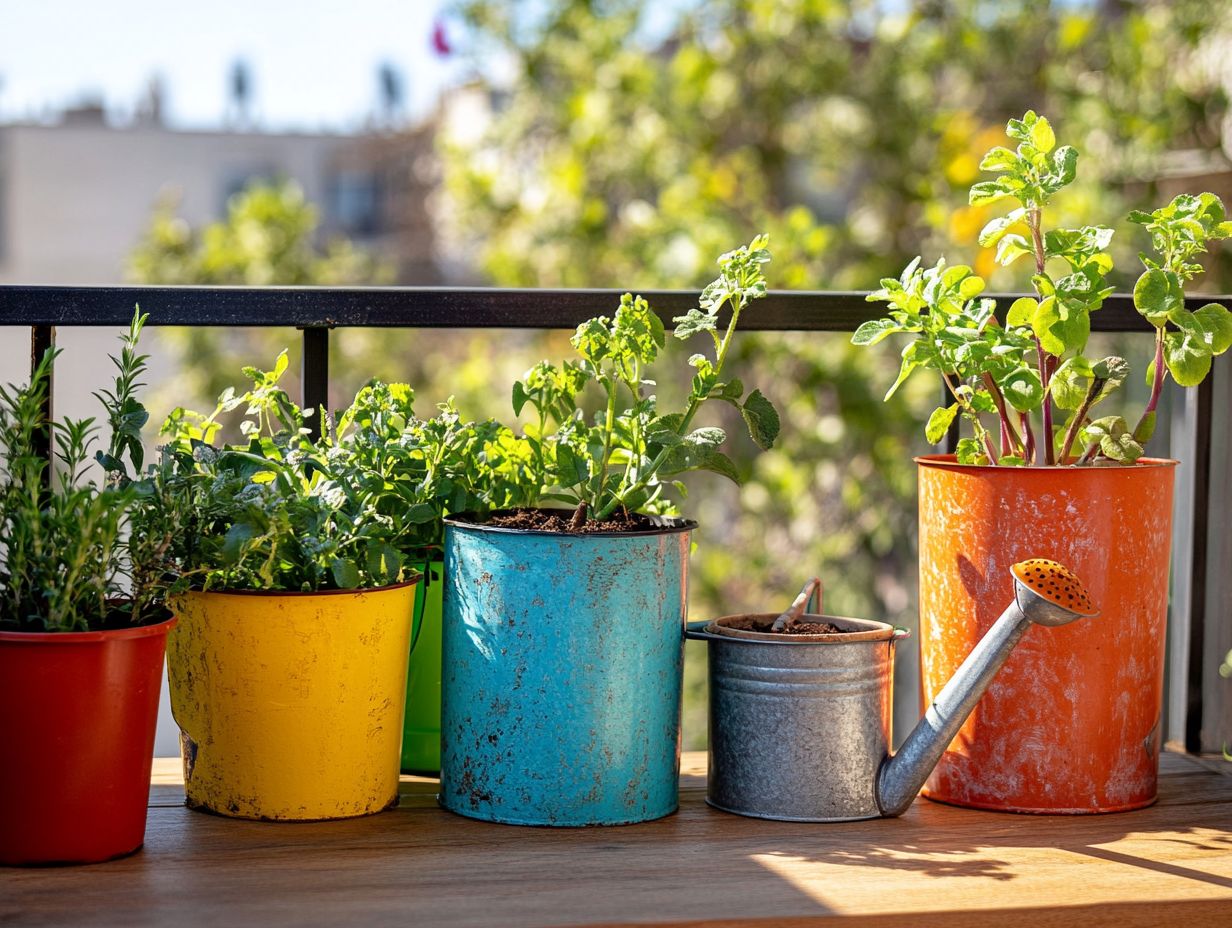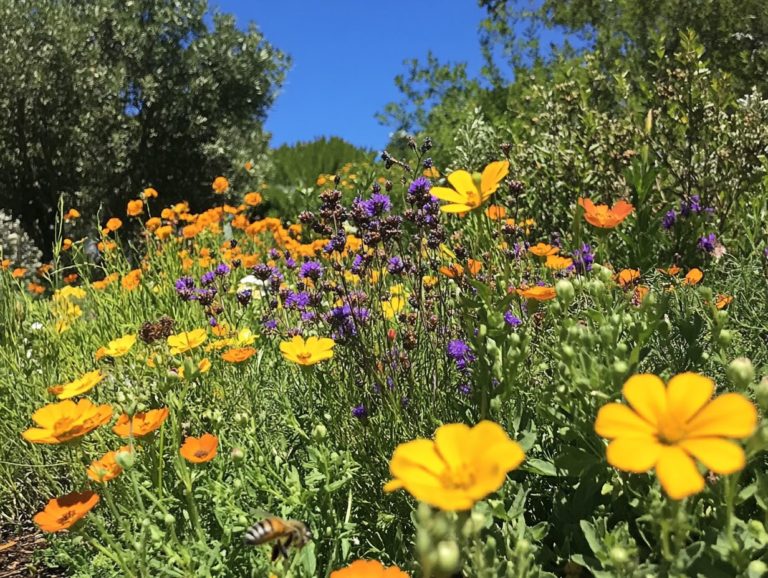Best Practices for Urban Drought Gardening
In an age where urban environments face persistent water scarcity, grasping the art of creating and maintaining a drought garden is paramount! With an emphasis on drought resilience, you’ll be thrilled to discover essential methods to transform your outdoor space.
This guide equips you with the essentials of urban drought gardening. Learn how to evaluate water availability, choose drought-resistant plants, and apply efficient watering techniques, while incorporating proactive gardening methods.
You ll be amazed at the alternative gardening methods and invaluable long-term maintenance tips to ensure your garden flourishes even in adverse conditions!
Contents
- Key Takeaways:
- What is Urban Drought Gardening?
- Preparing for Drought Conditions
- Watering Techniques for Urban Drought Gardens
- Maintaining a Drought Garden
- Alternative Gardening Methods for Drought Conditions
- Creating a Sustainable Drought Garden
- Frequently Asked Questions
- What are the best practices for urban drought gardening and proactive gardening?
- How can I conserve water while gardening in an urban area?
- Are there any tips for maintaining a healthy garden during a drought?
- What are some ways to reduce water usage in an urban garden?
- Can I still have a lush garden in an urban area with limited water resources?
- What else should I consider for urban drought gardening?
Key Takeaways:

- Choose drought-resistant plants to save water.
- Regular pruning and fertilizing maintain a healthy drought garden. Alternative methods like container gardening and hydroponics enhance sustainability.
- Long-term planning and maintenance are crucial for creating a sustainable drought garden in urban environments.
What is Urban Drought Gardening?
Urban drought gardening is essential for bolstering drought resilience, especially in regions experiencing unpredictable rainfall and escalating drought conditions in Pennsylvania. This innovative approach combines proactive techniques with best strategies for budget drought gardening, allowing your home garden to thrive with limited water resources.
By embracing methods like Xeriscaping a landscaping method that reduces or eliminates the need for irrigation and effective soil moisture management, you can contribute to water conservation while fostering habitats that support local pollinators.
Preparing for Drought Conditions
Preparing for drought conditions requires simple, clear steps. Begin by assessing water availability and understanding local climate factors.
These elements are essential for successful gardening in areas prone to drought, especially in cities like Denver and California.
Assessing Water Availability
Assessing water availability is crucial to your success in drought gardening. Evaluate soil moisture levels, check rainwater capture systems like rain barrels, and implement efficient tree irrigation methods.
By taking a multifaceted approach, you can ensure your plants thrive even in arid conditions. Techniques like soil testing provide insights into moisture retention, helping you pinpoint the best times for watering. Monitoring rainfall with precise tools keeps you informed about natural water inputs and aids in planning supplemental irrigation.
Incorporating practical water-saving practices such as drip irrigation (a watering system that delivers water directly to the roots of plants) and mulching dramatically reduces your water usage while boosting your garden’s health. Integrating native plants that require less hydration further refines your overall water management strategies.
Choosing Drought-Resistant Plants
Choosing drought-resistant plants is vital for cultivating a sustainable garden in challenging drought conditions. Consider options from drought evaders to drought conservers, each exhibiting unique adaptations, such as deep taproots or ornamental grasses like Kentucky bluegrass.
These plants thrive with minimal water and elevate urban landscapes, infusing them with vibrant colors and rich textures. For instance, Eryngium yuccifolium, known as the Rattlesnake Master, features striking blue-gray foliage that attracts pollinators, enhancing biodiversity.
Then there are Virginia bluebells, boasting delicate blooms that provide seasonal beauty with minimal maintenance. By incorporating resilient species like these, you can create visually stunning yet eco-friendly spaces that conserve water and support local wildlife! These are truly ideal choices for the modern urban gardener.
Watering Techniques for Urban Drought Gardens

Implementing effective watering techniques is essential for urban drought gardens. Focus on efficient watering methods and innovative water conservation strategies. For more information, explore best practices for drought-resistant gardening and use rain barrels to ensure your plants receive the necessary moisture during dry spells.
Prioritizing these approaches will help you cultivate a thriving garden, even in challenging conditions.
Efficient Watering Methods
Efficient watering methods like tree irrigation and incorporating compost are crucial for providing essential moisture to your plants and combating city heat.
Utilizing techniques such as drip irrigation a method that delivers water directly to plant roots through a network of tubing and rainwater harvesting can greatly enhance moisture efficiency. For example, a community garden in Chicago adopted drip irrigation and compost application, resulting in a remarkable 30% increase in plant health. This illustrates the powerful benefits of combining adequate hydration with organic matter.
Integrating compost into your soil improves its structure and promotes better water retention. This is especially vital in city landscapes that often face drought conditions, supporting initiatives like the Grow Green Guide. Research shows that compost-rich soils can retain up to 20% more moisture than their less organic counterparts. This makes compost an essential component for sustainable gardening in urban environments while promoting methods like Composta.
Water Conservation Strategies
Water conservation strategies such as using rain barrels and adopting various water-saving practices are crucial for adapting to climate challenges and ensuring your garden thrives sustainably during drought conditions.
Implement these methods, including tree irrigation and strategic pruning, to significantly enhance your garden s resilience while also reducing those water bills. Techniques like drip irrigation and mulching not only help retain soil moisture but also reduce evaporation on scorching days. Opting for native plants that require less water will further bolster your garden’s sustainability.
Stay alert to weather changes to keep your garden thriving. Adjust your watering schedule accordingly to maximize efficiency, crucial for climate adaptation. Incorporating compost into your soil improves its water-holding capacity, allowing your plants to flourish even in challenging conditions.
Maintaining a Drought Garden
Maintaining a drought garden requires a thoughtful approach to both pruning and fertilizing. Focus on enriching the soil with organic matter, as this plays a crucial role in supporting plant health. Additionally, implementing water-saving gardening techniques for drought can enhance resilience during dry conditions.
Pruning and Fertilizing Tips
Pruning and fertilizing are vital for nurturing drought gardens. Concentrate on techniques that strengthen plant structure and enhance organic matter retention in the soil.
These techniques help maintain a robust and healthy garden in arid conditions while optimizing resource use for each plant. Research shows that strategic pruning significantly improves air circulation and light penetration, essential for drought-resistant species.
Prune during the plant’s dormant season to minimize stress, ensuring they enter the growing season in peak condition. Incorporating slow-release organic fertilizers deeply nourishes the roots, enhancing nutrient access while reducing water loss.
Utilizing compost enriches your soil, boosting its moisture-retaining capabilities and fostering a productive micro-ecosystem essential for urban gardening success. By following these recommendations, your drought gardens can flourish beautifully, even in the most challenging climates.
Conclusion: Effective watering techniques, composting, and best practices for vertical drought gardening are key to sustaining urban drought gardens. Start implementing these strategies today to enjoy a vibrant and resilient garden!
Alternative Gardening Methods for Drought Conditions

Explore alternative gardening methods like container gardening and hydroponics. These innovative ideas for drought gardening help manage drought conditions and conserve water in urban environments, supporting efforts from organizations like the Penn State Master Gardener program. These approaches maximize space while enhancing sustainability. Practices promoted by the California Institute for Water Resources allow you to cultivate a thriving garden while being mindful of resource conservation.
By embracing these techniques, you can create a flourishing green space that thrives even in challenging conditions.
Container Gardening and Hydroponics
Container gardening and hydroponics are exemplary sustainable practices that enable you to manage water usage effectively while cultivating plants. For those interested in enhancing their gardening efforts, learning how to create a sustainable drought garden can be particularly beneficial, especially in limited spaces during drought conditions.
These methods maximize water efficiency and allow urban dwellers to grow a diverse array of plants without the need for a traditional garden plot. If you’re contemplating container gardening, select the right containers and soil mix, such as Australian native grasses, to significantly improve plant health. Opt for self-watering pots to conserve moisture and reduce the frequency of watering.
Hydroponics is a soilless gardening method where nutrient-rich water fosters plant growth, making it an excellent choice for urban environments. By incorporating simple systems like vertical gardens or drip irrigation, even beginners can cultivate a flourishing green space, contributing to sustainable living in cities grappling with water scarcity.
Creating a Sustainable Drought Garden
Start creating your sustainable drought garden today by planning wisely! Thoughtful, long-term planning and meticulous maintenance practices prioritize water conservation and nurture ecological balance. For more insights, explore the benefits of drought gardening for urban areas, ensuring your garden thrives even in the face of changing climate conditions.
Long-Term Planning and Maintenance
Long-term planning and maintenance are essential for a sustainable drought garden. They ensure your plants are well-suited to the shifting climate and can thrive under varying water conditions.
To achieve this, prioritize selecting native plants like Virginia bluebells and Kentucky bluegrass. These plants flourish in your local climate, require minimal irrigation, and enhance local biodiversity. Implement a seasonal strategy to adapt to changing weather patterns, allowing timely planting and harvesting while reducing water stress on your plants.
Mulching around your plants conserves moisture, while using compost enriches the soil with organic matter, boosting its ability to retain water. Incorporating rain gardens and rain barrels helps harness nature s resources effectively, contributing to soil moisture.
By understanding and adapting to your environment, you can cultivate resilient gardens that not only survive but thrive amid climate variability. Utilize a gardening method that reduces the need for irrigation and engage with local pollinators.
Frequently Asked Questions
What are the best practices for urban drought gardening and proactive gardening?

1. Use native and drought-resistant plants: Native plants are adapted to the local climate and require less water. To learn more about this, check out how to plan a drought-resistant community garden. Drought-resistant plants, such as succulents, also have low water requirements and are perfect for urban gardens.
How can I conserve water while gardening in an urban area?
2. Use drip irrigation: Drip irrigation systems deliver water directly to the plant’s roots, reducing evaporation and water waste. They are also more efficient than traditional sprinkler systems.
Are there any tips for maintaining a healthy garden during a drought?
3. Mulch, mulch, mulch: Adding a layer of mulch around plants helps retain moisture in the soil and suppresses weed growth. Organic mulches, like bark chips or straw, are best for retaining moisture.
Join the movement for sustainable gardening today!
What are some ways to reduce water usage in an urban garden?
Collect rainwater by installing a rain barrel. This method helps save water and cuts costs on your bill!
Can I still have a lush garden in an urban area with limited water resources?
Container gardening offers better control over water usage. Use large containers with good drainage and group plants with similar needs.
What else should I consider for urban drought gardening?
Regular maintenance is key! Check for leaks in hoses and fix them immediately. Overwatering can cause root rot, so stick to water-saving practices.






